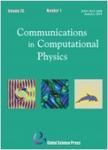A Model Study on the Generation of Internal Tides by Tidal Flows Over a Submerged Seamount in the Channel
作者机构:LEDSouth China Sea Institute of OceanologyChinese Academy of SciencesGuangzhou510301China Graduate School of the Chinese Academy of SciencesBeijing100049China
出 版 物:《Communications in Computational Physics》 (计算物理通讯(英文))
年 卷 期:2010年第8卷第6期
页 面:95-114页
核心收录:
基 金:jointly supported by the Key Program KZCX1-YW-12-03 from the Chinese Academy of Sciences “863”Hi-Tech Programs(Nos.2008AA09Z112 and 2008AA09A402) NSFC Grant No.40676021 National Special Project 2006BAB19B01 Grant 2007B030200004 from Guangdong Province of China
主 题:Internal tides numerical modeling two-layer model sill channel
摘 要:It is known that the submerged seamount/ridge is a source for the generation of internal *** this paper,a three-dimensional two-layer model is set up to study the generation of internal tides by tidal flows over a submerged seamount/ridge in the *** numerical experiments with different topographic features,upper layer depths,tidal flows and background currents are carried out to study the variations of the induced internal *** is shown that,for the specific stratification,the seamount feature,the slope,the initial upper layer depth and the imposing driven force determine the Froude number near the seamount *** when the Froude number is supercritical,the associated maximum amplitude of the induced internal tide is so large that the internal tide begins to disintegrate,which brings about severe variations of the current velocity and the water elevation fields,and the associated induced baroclinic tidal energy around the seamount peak is much larger than the barotropic *** Richardson number greater than 1/4 is a criterion for stability of shear *** the maximum tidal velocity changes within 0∼360◦with time in a period around the seamount peak,the induced internal tide does not stride the seamount peak before it disintegrates,which is different from the two-dimensional modeled *** asymmetrical slope of the submerged seamount is a mechanism for the asymmetrical internal tide generation.



